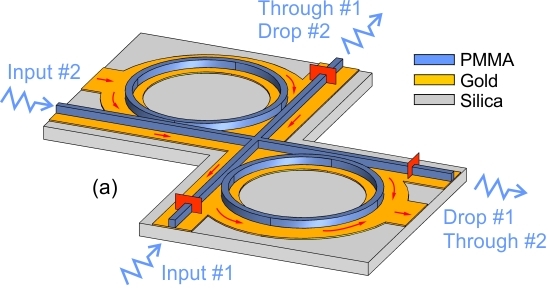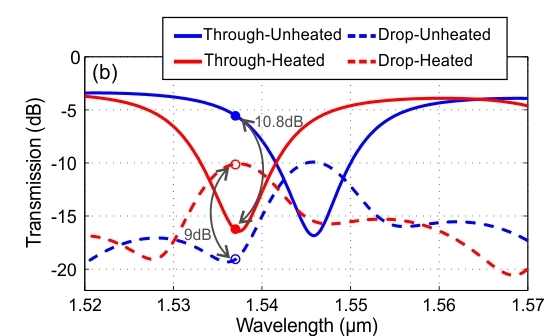
Guided-wave plasmonics is concerned with the manipulation and routing of surface plasmon polaritons (SPPs), electromagnetic surface waves coherently coupled to collective oscillations of a metal’s free electron density. SPP waves propagate along a metal-dielectric interface and feature an exponential decay of the field components away from it.
Plasmonic waveguides comprising at least one metal-dielectric interface can support guided modes having a spot size of sub-wavelength dimensions, breaking the diffraction limit. Thus, plasmonic components can be employed in nanophotonic integrated circuits, combining the bandwidth of photonics along with nanoscale dimensions.
In order to assemble fully operational plasmonic circuits, one must address the need for efficient switching/routing elements. Currently, our research focuses mainly on thermally tunable plasmonic components based on the Dielectric-Loaded Surface Plasmon Polariton (DLSPP) waveguide. Thermo-optic control is naturally compatible with DLSPP-based components, since the same thin metal circuitry used for supporting the plasmonic mode can be used for carrying the control current as well. More importantly, such components can be quite efficient, since the supported mode exhibits its maximum just above the metal-dielectric interface.
Plasmonic waveguides comprising at least one metal-dielectric interface can support guided modes having a spot size of sub-wavelength dimensions, breaking the diffraction limit. Thus, plasmonic components can be employed in nanophotonic integrated circuits, combining the bandwidth of photonics along with nanoscale dimensions.
In order to assemble fully operational plasmonic circuits, one must address the need for efficient switching/routing elements. Currently, our research focuses mainly on thermally tunable plasmonic components based on the Dielectric-Loaded Surface Plasmon Polariton (DLSPP) waveguide. Thermo-optic control is naturally compatible with DLSPP-based components, since the same thin metal circuitry used for supporting the plasmonic mode can be used for carrying the control current as well. More importantly, such components can be quite efficient, since the supported mode exhibits its maximum just above the metal-dielectric interface.
Another tuning mechanism is accessible by using nematic liquid crystals (LC) as the loading of a DLSPP waveguide. Taking into account that the polarization of the SPP waves is perpendicular to the metal film (TM), the LC director can be switched between that direction and one tangential to the film by means of an externally applied voltage, thus considerably affecting the propagation constant of the guided mode. This structure can be used in phase modulators or directional coupler switches.
References
- A. C. Tasolamprou, D. C. Zografopoulos , and Em. E. Kriezis, "Liquid crystal-based dielectric loaded surface plasmon polariton optical switches," Journal of Applied Physics, 110 (9), 093102, (2011).
- A. Pitilakis and Em. E. Kriezis, "Longitudinal 2x2 switching configurations based on thermo-optically addressed dielectric-loaded plasmonic waveguides," IEEE/OSA Journal of Lightwave Technology, 29 (17), pp. 2636-2546, (2011).
- O. Tsilipakos, Em. E. Kriezis and S. I. Bozhevolnyi, "Thermo-optic microring resonator switching elements made of dielectric-loaded plasmonic waveguides," Journal of Applied Physics, 109 (7), 073111, (2011).




